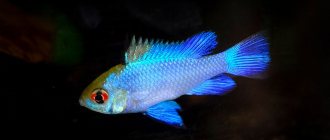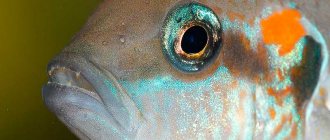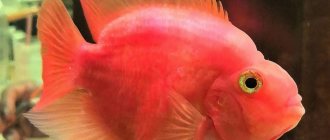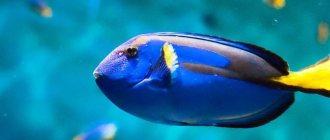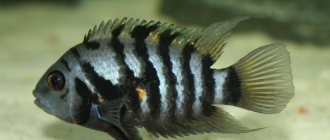Apistogramma cacatuoides is an aquarium fish with an unusually interesting appearance, reminiscent of a parrot, which is the reason for its name. These fish are very unpretentious, so breeding and keeping them is quite simple, no special hassle is required. However, relatively few hobbyists keep them in their aquariums. It is difficult to explain this precisely; presumably, the fact is that the young of this species have a dull and inconspicuous color. Apistogramma cockatoo belongs to the cichlid family. It combines many different species found throughout the world. South America is considered the homeland of these fish.
Habitat
This fish was first described in detail in 1951. In natural bodies of water, the apistogramma cockatoo prefers shallow and calm places with a very slow current: calm streams and rivers, backwaters. Their bottom is usually covered with a layer of fallen branches and leaves. As a result of decay, the acidity of the water increases, the pH decreases and it becomes much softer. That is, the composition of the water changes noticeably depending on the season.
How long do these dwarf cichlids live? Usually about 3-4 years
What to feed
Under natural conditions, dwarf cichlids eat larvae of aquatic insects, small invertebrates, and detritus. In the aquarium, they eat fresh and frozen equally well:
- Daphnia;
- bloodworm;
- coretra;
- tubifex;
- cyclops;
- Artemia.
They can pluck the tender leaves of aquatic plants and also eat dry food. When choosing it, it is necessary to take into account the size of the granules. Slow-sinking flakes will also work. The krill content in dry food makes it more attractive to dwarf cichlids. The portion should be such that the fish can eat it completely. Although cockatoos can collect food from the surface of the soil, the abundance of decaying debris will pollute the water with ammonia and nitrates, to which the fish are very sensitive.
Appearance
The cockatoo's apistogram has a number of distinctive features. First of all, when describing it, it should be noted that the dorsal fin of the male has front rays that are longer than the others, and this makes them look like the crest on the head of a parrot. They have a large and usually slightly open mouth. And the lower jaw is massive and protrudes forward. Their muscular body is elongated and laterally flattened.
As for coloring, it has options. Usually the main color is yellow-golden, the back has an olive tint, and dark spots are scattered on it. The abdomen may be orange-red. There are dark stripes on the sides along the entire length of the body. The caudal fin is lyre-shaped and most often has orange-scarlet spots on it.
Feeding and diet of the Apistogramma cockatoo
You should also pay attention to the diet of apistograms. Our recommendation is to keep them on dry military rations and not overfeed. Under no circumstances should you feed it with live food or any dry daphnia or gamarus. To prevent them from swelling, swelling and hooking, take proven branded food. Our recommendation, and I think you will agree with it, is Tetra food, which has been tested by more than one generation of aquarists. For example, food from the Tetra Ruby or Tetra Color series are perfect. They contain carotenoids that will enhance the color of colorful apistograms.
It should be noted that when purchasing any dry food, you should pay attention to the date of its manufacture and expiration dates, try not to buy food in bulk, and also store the food in a closed state - this will help avoid the development of pathogenic flora in it.
Maintenance and care
There are usually no particular difficulties in maintaining a cockatoo apistogram. Even inexperienced amateurs can cope with breeding them at home, because this species is quite unpretentious. However, you should remember a few rules that must be followed when caring for such fish.
First, you need to take into account that the water in the aquarium should be quite soft, the pH slightly shifted to the acidic side. A constant temperature is required, about 23-25°C, because these fish do not like sudden changes. In addition, for complete comfort, they need to bring their living conditions as close to natural as possible. The size of the aquarium required is not particularly large: for a couple of individuals a capacity of approximately 60 liters is required. If you plan to keep a group - one male and several females, then it should be approximately 70 liters. Aeration of water is necessary.
It is recommended to use dark soil to decorate the aquarium; this will beautifully highlight the attractive colors of the charming fish. At the bottom you should install driftwood and stones in different places so that the fish have somewhere to hide. Plants need to be planted densely enough so that they gently diffuse the light.
Introduction
Apistogramma cockatoo can confidently be called one of the most undemanding fish in terms of keeping conditions.
Aquarists are attracted by the bright colors of this dwarf cichlid. The name of the fish in Latin is Apistogramma cacatuoides.
— Advertising —
The first description of the fish dates back to 1951. The homeland of the apistogramma cockatoo is considered to be Brazil and Bolivia, where it is found in the tributaries of the Amazon, Uquali, and Solymos rivers. These fish love areas with calm currents or standing waters: quiet creeks and streams, the bottom of which is covered with fallen leaves. Under these conditions, water parameters are highly dependent on seasonal climate changes: water temperature and its hardness change.
These small cichlids are schooling fish and feel comfortable in a company with a predominance of females.
The Apistogramma cockatoo is a brightly colored small fish with a long body that is flattened on the sides. The mouth opening is small with a strong lower jaw. The main body color of the fish can be of various shades from grayish-yellow to brownish with a blue sheen on the sides, the back is greenish-olive, the chest and belly area are all shades of yellow (even bright orange). A dark stripe runs along the entire body, ending at the base of the tail. Dark spots are scattered along the back, there are many of them at the base of the dorsal fin. The dorsal fin attracts attention - its outline is defined by two black rays, the main part is painted in bright shades of green and orange, with a red border along the edges. It was precisely because of the shape and color of the dorsal fin that this cichlid was named “Apistogramma Cockatoo”.
The male of this fish grows up to 8-12 cm in length, the female is usually smaller - only 5-7 cm. Like other members of the genus, Apistogramma cockatoos live from 5 to 7 years.
Reproduction and breeding
These fish are polygamous in nature, living in harems: several females and one male. Such a harem protects its territory, not allowing strangers near it.
Before spawning begins, the male performs a mating dance in front of the females, bending beautifully and showing his bright colors. Females spawn approximately 80 eggs at a time, attaching them to a smooth surface, usually the inner wall of the aquarium, and take care of them; she removes dead eggs. The male fertilizes them and protects the eggs and the female; if there is more than one female, then he visits the shelters of each of them and fertilizes all the laid eggs. While caring for the eggs, the color of the females may turn yellow.
The fry hatch after 3 or 4 days. Interestingly, females from the same harem can steal each other’s fry, dragging them into their flock. After another 3-4 days, the fry are already swimming well. They grow very quickly. Live dust, small worms, and crushed egg yolk can be used as food for them.
Apistogramma video review +
Subscribe to our YouTube channel so you don't miss anything
Peaceful cichlidsCichlidsPopular fish
Category: Aquarium articles / Aquarium fish | Views: 1,226 | Date: 25-02-2019, 17:56 |
We also recommend reading:
- — Apistogramma gold
- — Lifehook for cleaning a CO2 diffuser
- — Scary mutant fish and freaks in our aquariums
- — Which coal is better for an aquarium?
- — All about aquarium hoses for filter, CO2 and aeration
Compatibility with other fish
Apistogramma cockatoos are quite peaceful. Only during spawning can they become aggressive, protecting their territory. They can be successfully kept with other species of approximately the same size and calm disposition. Cockatoos get along very well with characins, tetras, and barbs.
If the aquarium contains more than one male Apistogramma cockatoo, it should be large enough to provide space. Otherwise, the dominant male will bother the other and disturb him. If the males are approximately equal in strength, then constant clashes between them are inevitable.
Description of the aquarium fish
Nowadays, few people keep the cockatoo apistogram. This is due to the fact that the fry have an unsightly coloring, which becomes bright when the fish becomes an adult. Breeders managed to breed individuals with many bright colors.
The fish is called cockatoo because of its dorsal fin. Its first rays look like the crest of a bird. The body, slightly flattened on the sides and elongated, has a golden color. A black stripe runs along the entire body, and the belly is yellow. A blue tint can be seen on the ventral fins and gill covers. The remaining fins are red-orange.
It is very easy to distinguish a male from a female. Males grow up to 7.5 cm, and females are much smaller - about 5 cm. “Boy” fish are bright, but “girl” fish lack a crest and the colors are not so bright.
Photo of apistogramma cockatoo
Technical Tips
As already mentioned, these are easy-to-keep aquarium cichlids, but some conditions still need to be met. Apistogramma cockatoos will do well in aquariums equipped with quiet places and secluded corners (one for each female). For a harem (dominant male + three or four females) a volume of 70 liters is sufficient. If you have more than one male, then the aquarium should be at least twice as large. They react painfully to increased levels of nitrates and ammonia, so the purity of the water in their content is the main thing.
Female apistogramma cockatoo Lighting – soft, diffused. Dense vegetation, including floating vegetation, will help ensure this regime. They prefer water with moderate currents and high oxygen content. Maintain water temperature 24-27 °C, slightly acidic, up to 6.5 pH, soft water.
Arrangement and parameters of the aquarium
For a pair you will need a container of at least 50 liters, but it is better to keep a male with several females. A flock requires a container of at least 100 liters. Loves shelters made of stones, snags, caves, grottoes, as well as dense thickets of plants. The soil needs to be soft, since fish that stay near the bottom constantly dig in it.
Water parameters
Temperature: optimal 25 - 27° C (upper and lower limit 22-30° C); pH: 6.5-7.5; Hardness: 5 - 12° GH.
Effective filtration with aeration and regular water changes are necessary. Fish are very susceptible to nitrates.
Except during the spawning period, they are not aggressive and can be kept with species of similar size. In exceptional cases, large males attack small fish.
Spreading
Apistogramma cockatoo is found in South America - Colombia, Peru, Bolivia, Brazil.
The fish inhabits quiet, shallow reservoirs of the tropics. It stays close to natural shelters - roots, stones, flora. At first, the habitat of the apistogramma cockatoo was indicated incorrectly - Paramaribo, Suriname. But later changes were made. It is clarified that the cockatoo cichlid is found in the Amazon between 69° and 71° west longitude.
Character and neighborhood
Despite the fact that Apistogramma are the most peaceful species among cichlids, they are territorial fish and behave aggressively with small neighbors. For large fish they can serve as prey. Therefore, when selecting species for a community aquarium, it is worth considering:
- size;
- activity;
- aggressiveness;
- habitat – you should not house small bottom-dwelling fish.
Neighborhood with large cichlids and lokaria catfish is contraindicated. Cockatoos will make friends with other species of dwarf cichlids, barbs, tetras, platies, swordtails, angelfish, and mollies. But peaceful coexistence is possible if the aquarium is quite large.
Apistogramma cockatoo is a beautiful and interesting fish, which, unfortunately, is not often found in domestic aquariums. Perhaps lovers will soon appreciate it, and it will take its rightful place in the domestic reservoirs of our country.
Behavior
Apistogramma - cockatoo - the fish is not aggressive, but during the spawning period it will very resolutely defend its territory. Males are polygamous; there should be several females on their territory. The best neighbors: fiery, mossy, Sumatran barbs; tetra minora or rhodostomus; catfish speckled, panda, bronze); characinka neons or rasboras. Apistogramma cockatoos will certainly eat fry and small invertebrates (shrimp). To see what these aquarium cichlids look like, the video is posted just below.
Feeding
Invertebrates, plankton and detritus act as food.
Live food:
- daphnia;
- tubifex;
- mosquito larvae;
- coretra, etc.
It is also possible to use sinking dry ready-made (flakes, granules).
In the process of eating food, the fish carefully collect food from the bottom, however, they do not dig through the substrate. Tend to overeat.
The Apistogram should be fed frequently, in small portions, carefully chopping the food.
Diseases and prevention
Apistogramma immunity is reduced by stress, poor quality water and constant overeating. Fish can become infected with viruses, bacteria or parasites.
- It is impossible to cure fish from viruses , so quarantine should not be neglected when purchasing new aquarium inhabitants.
- The scales of apistograms are often parasitized by ichthyophthyriosis . It is treated with an antibacterial drug added to the general aquarium.
- pathogenic bacteria appear in the water . Infected apistogramma look lethargic, there is no appetite, and the fish even die. It is difficult to find an effective drug for treatment, so it is better to monitor the quality of the water.
It is a pleasure to watch bright apistogrammas, but a capricious aquarium fish cannot exist in inappropriate conditions and without proper care.


